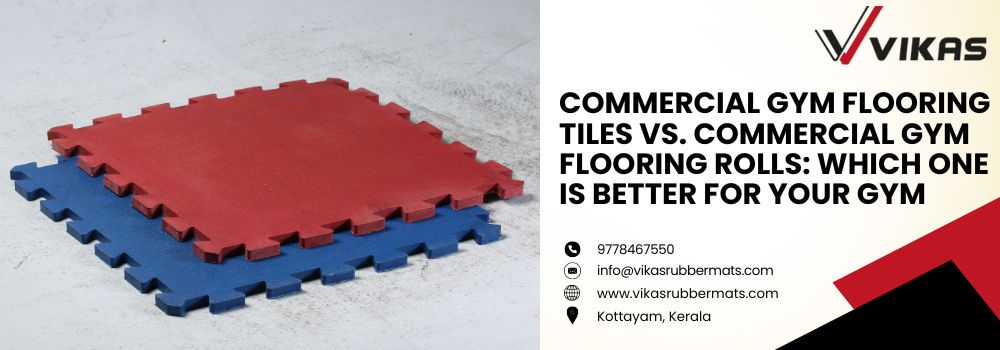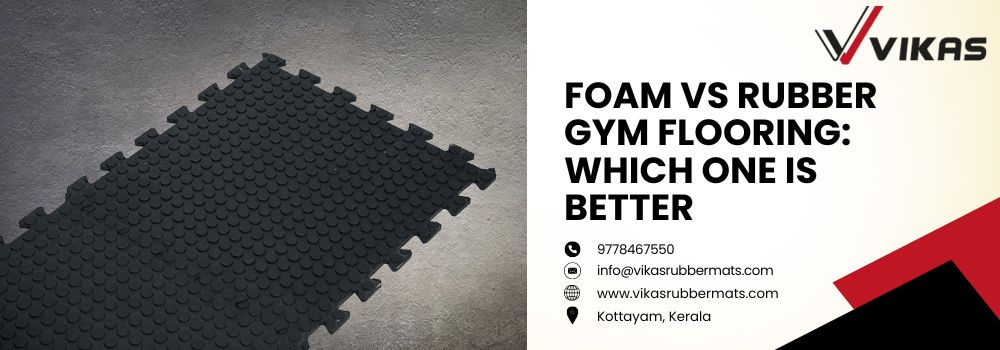
When it comes to setting up a home gym or commercial fitness facility, one of the most important decisions you'll have to make is choosing the right flooring material. Are you confused by the many options when purchasing gym floor mats for your home gym or commercial gym? When choosing between Rubber gym floor tiles and rubber gym floor tiles, it is important to consider the unique needs of your gym to determine which option is best for your needs. Foam and rubber are two popular options, each with its own set of pros and cons. For the safety of the person and the floor, it is very important to invest in your gym floor.
Foam and rubber flooring create a robust surface that safeguards against negative impacts while establishing a clean environment. Both foam mats and rubber mats are available in a diverse range of designs, materials, sizes, and colors. You can select anything that matches your preferences and the vibe of your club. Vikas Rubber Mats provides a guide for selecting between foam flooring and rubber flooring. In this article, we will compare foam gym flooring with rubber gym flooring to assist you in deciding which option is more suitable for your requirements.
Foam flooring and rubber flooring provide a durable surface to protect against harmful effects while creating a hygienic area. Both form mats and rubber mats came in a wide variety of designs, materials, sizes, and colours. You can go for anything that suits you and the atmosphere of your club. Vikas Rubber Mats offers a guide to choosing Form flooring or rubber flooring. In this article, we'll compare foam vs rubber gym flooring to help you determine which one is better suited for your needs.
Foam Gym Flooring
A foam gym flooring is a flexible type of board made from a synthetic material called EVA foam. Foam mats are usually made of interlocking tiles. These tiles are made in a variety of bright colours, so they are widely used for children's play areas. But for gyms, there are more colours that catch the eye. Foam gym flooring is lightweight, affordable, and easy to install. It provides a cushioned surface that is ideal for high-impact exercises and can help reduce the risk of injury. However, foam flooring is not as durable as rubber and may not hold up well to heavy equipment or constant foot traffic. It's also prone to indentations and can be easily damaged by sharp objects.
Pros of Foam Gym Flooring:
- Lightweight and easy to install
- Provides cushioning for high-impact exercises
- An affordable option for home gyms
- Available in a variety of colours and thicknesses
Cons of Foam Gym Flooring:
- Not as durable as rubber
- Prone to indentations and damage
- May not hold up well to heavy equipment
- Less versatile for different types of workouts
Also Read: Commercial Gym Flooring Tiles Vs. Commercial Gym Flooring Rolls: Which One is Better for Your Gym
Rubber Gym Flooring
Rubber flooring is the most common flooring in gyms. And with good reason. It gives the gym a professional look without costing money. Rubber gym flooring is known for its durability, versatility, and easy maintenance. It can withstand heavy use, including the weight of gym equipment and constant foot traffic. Rubber flooring is also shock-absorbent, which can help reduce noise and vibration during workouts. However, rubber flooring tends to be more expensive than foam and may have a strong odor when first installed. But do the pros outweigh the cons?
Pros of Rubber Gym Flooring:
- Durable and long-lasting
- Versatile for various types of workouts
- Shock-absorbent and reduces noise
- Easy to clean and maintain
Cons of Rubber Gym Flooring:
- More expensive than foam
- May have a strong odor when first installed
- Heavier and harder to install than foam
- Limited color options compared to foam
Choosing the Right Flooring For Your Gym
- Choosing between form mat flooring and rubber mat flooring for a gym depends on various factors such as budget, materials, space, theme, size, design, and many more.
- Rubber gym flooring mats have come with customization options and safety features. You can customize them according to your needs and choices.
- Gym rubber flooring covers a larger area with more cushioning properties. This rubber flooring is an affordable solution for large rooms and is easy to maintain.
Since 1977, Vikas Rubber Mats has been recognized for providing the best rubber mats in PAN India as well as globally. We offer a wide range of gym rubber mats and gym rubber rolls which are made from high-quality rubber materials that provide high durability and easy maintenance. Vikas rubber mat has a wide range of rubber mats and rolls to cover all your gym flooring needs. For more information, call Vikas Rubber Mats today at +91 96450 05044.
Which One is Better?
So, which type of gym flooring is better - foam or rubber? The answer ultimately depends on your specific needs and budget. If you're setting up a home gym on a tight budget and prioritize cushioning for high-impact exercises, foam flooring may be the better option for you. However, if you're looking for a durable, long-lasting solution that can withstand heavy use and various types of workouts, rubber flooring may be the way to go.
Both foam and rubber gym flooring have their own set of advantages and disadvantages. It's essential to consider factors such as durability, cushioning, maintenance, and budget when deciding between the two options. Ultimately, the best choice will be the one that meets your individual needs and preferences.
Certification












